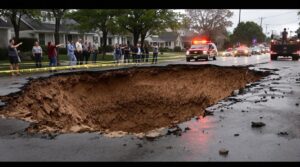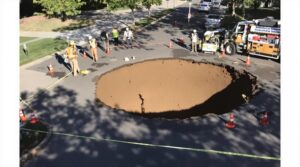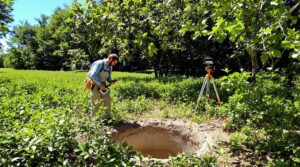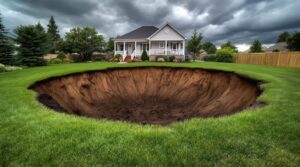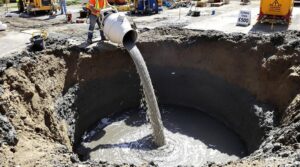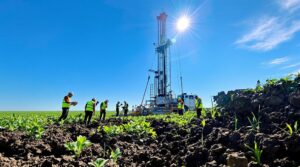Warning signs of sinkholes manifest through multiple observable indicators. Property owners should monitor for circular ground depressions, unexpected water accumulation, and vegetation changes such as sudden wilting or death. Structural indicators include foundational distress patterns, wall-ceiling separations, and cracks exceeding 1/4 inch in width. Environmental signals encompass turbid well water, new pond formation, and distinct microclimates. Understanding these indicators enables thorough risk assessment and mitigation strategies.
Key Takeaways
- Circular ground depressions, unexpected water accumulation, and tilting trees with exposed roots indicate potential sinkhole development.
- New cracks in walls, floors, or foundations, especially those wider than 1/4 inch, suggest ground instability beneath structures.
- Sudden wilting or death of vegetation patterns and turbid well water can signal underground erosion leading to sinkholes.
- Standing water in typically dry areas and the formation of new ponds where none existed before warn of possible sinkhole formation.
- Doors and windows becoming difficult to close, along with wall-ceiling separations, indicate structural stress from ground movement.
Understanding What a Sinkhole Is and Why They Form
Sinkholes represent geologic hazards characterized by surface depressions or cavities formed through the collapse of underlying ground layers. These geological phenomena occur when subsurface erosion creates voids beneath the earth’s surface, eventually leading to the deterioration of supporting material and subsequent collapse.
The process of sinkhole formation primarily involves the dissolution of soluble rocks, such as limestone and dolomite, by acidic water penetrating through soil and rock. Sinkholes are most commonly found in karst regions where specific geological conditions exist.
These depressions can manifest in varying dimensions, spanning from one to 600 meters in diameter, with some water-filled formations extending beyond 1,200 meters in depth.
The mechanisms driving their development include both natural and anthropogenic factors. Natural processes encompass chemical weathering and physical erosion, while human activities such as groundwater extraction, mining operations, and construction can accelerate geological erosion.
Understanding these formation processes is vital for identifying potential hazard zones and implementing appropriate preventive measures in vulnerable areas.
Visual Signs in Your Property’s Landscape

Numerous visual indicators in a property’s landscape can signal potential sinkhole formation, warranting careful observation and documentation. Through systematic landscape inspection, property owners can identify critical warning signs that necessitate professional soil analysis. Key indicators include circular ground depressions, unexpected water accumulation, and sudden formation of ground voids. The presence of weak carbonic acid from rainwater gradually dissolves limestone beneath the surface, contributing to void formation.
| Terrain Feature | Observable Change | Risk Level |
|---|---|---|
| Ground Surface | Circular depressions, subsidence | High |
| Vegetation | Tilting trees, exposed roots | Moderate |
| Water Patterns | New pooling, drainage changes | Severe |
Advanced stages of sinkhole development manifest through distinct changes in plant behavior and soil stability. Trees and vegetation may exhibit unusual growth patterns or sudden tilting due to compromised root systems. Surface anomalies often appear in conjunction with water-related changes, such as the emergence of previously non-existent ponds or altered drainage patterns. These indicators frequently correlate with subsurface karst processes and warrant immediate professional evaluation.
Structural Changes to Watch For in Buildings
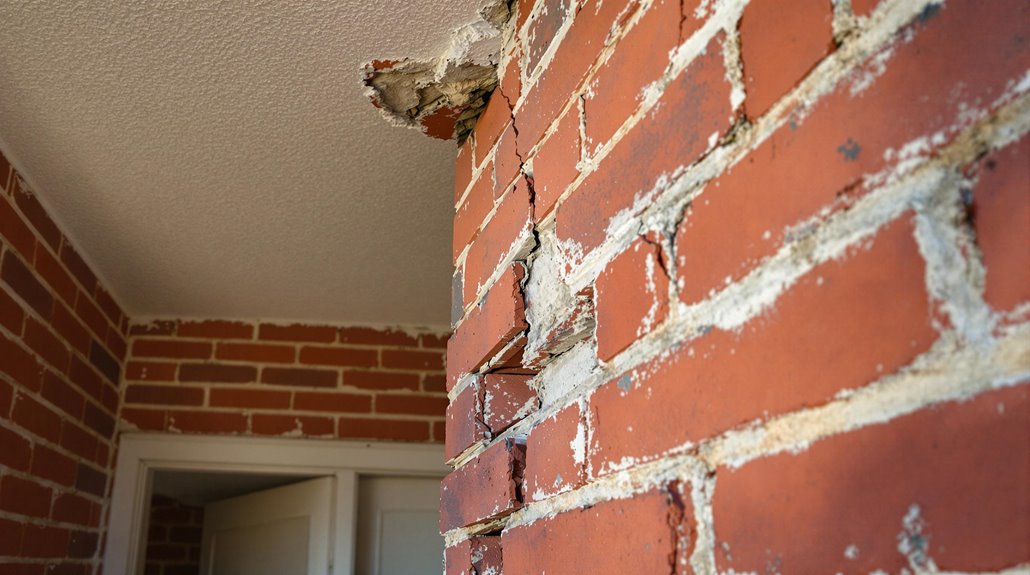
Differential settlement and lateral movement characteristic of sinkhole formation manifest through foundational distress patterns, including diagonal fractures exceeding 1/4 inch and stair-step cracking in masonry elements.
Progressive subsurface void development often produces wall-ceiling separations, with particular attention warranted to horizontal fissures and bulging surfaces that indicate compromised structural integrity. Regular assessment of any trim gap progression can provide early warning signs of developing sinkhole conditions.
The presence of misaligned door frames and persistent difficulty in window operation can signal underlying ground instability, as these issues typically emerge from foundation displacement associated with sinkhole activity.
Foundation Cracks and Shifts
Structural deterioration of foundations manifests through distinct warning signs that property owners must carefully monitor. During foundation inspection, particular attention should focus on crack patterns and their characteristics. Horizontal cracks exceeding 1/4 inch width, especially in load-bearing walls, indicate severe structural compromise requiring immediate professional assessment.
| Warning Sign | Severity Level | Key Indicators | Required Action |
|---|---|---|---|
| Horizontal Cracks | Critical | >1/4″ width | Immediate repair |
| Vertical Cracks | Moderate | >1/8″ width | Professional evaluation |
| Stair-Step Cracks | Serious | Any size | Structural assessment |
| Foundation Shifts | Critical | Growing cracks | Engineering consultation |
Comprehensive crack assessment must evaluate progression patterns, noting whether fissures expand over time. Stair-step configurations in masonry particularly warrant attention, as they frequently indicate substantial foundation movement and potential sinkhole development beneath the structure.
Wall and Ceiling Separation
Early detection of wall and ceiling separation provides critical indicators of potential sinkhole formation beneath buildings.
Structural manifestations typically present as distinct patterns of separation between building components. Observable indicators include diagonal wall cracks extending to ceiling joints, visible gaps around crown moldings, and pronounced ceiling sagging in affected areas.
Critical warning signs encompass bowing or leaning walls resulting from uneven foundation settlement, along with separation between ceiling fixtures and surrounding surfaces.
The progression often reveals itself through degrading structural integrity, evidenced by exposed joints between walls and ceilings. When these symptoms appear in conjunction with diagonal or zig-zag ceiling cracks, particularly in corner areas, they strongly suggest underlying ground instability characteristic of developing sinkholes.
Door and Window Issues
Significant changes in door and window functionality serve as crucial indicators of potential sinkhole formation beneath buildings. Observable manifestations include misaligned frames, operational difficulties, and structural deformations.
Door functionality issues often present as sticking mechanisms, improper closure, and visible frame distortion, while window integrity concerns manifest through warped frames, operational resistance, and peripheral cracking patterns.
Installation-related factors can exacerbate these warning signs, particularly when load-bearing walls are compromised during window modifications. Improper installation of large window units, inadequate structural support, and thermal expansion stress can accelerate foundation destabilization.
Additionally, the presence of gaps around frames, coupled with sagging or tilting components, suggests underlying ground instability characteristic of developing sinkholes. These structural anomalies require immediate professional assessment to prevent catastrophic failure.
Environmental and Vegetation Warning Signals

Understanding the environmental and vegetation warning signals of developing sinkholes requires careful observation of botanical, hydrological, and ecological indicators. Initial signs often manifest through vegetation wilting in circular patterns and unexplained dead patches of grass. Dense vegetation typically enhances soil stability, while sudden changes in plant health may indicate underlying geological activity.
| Environmental Factor | Primary Indicator | Associated Risk Level |
|---|---|---|
| Vegetation | Sudden wilting/death | High |
| Hydrology | Turbid well water | Moderate |
| Ground Structure | New depressions | Severe |
| Ecological Changes | Microclimate formation | Low |
The presence of standing water in previously dry areas, combined with changes in seasonal water patterns, warrants immediate investigation. Formation of new ponds and hydrological flow accumulation patterns can signal developing subsurface instability. Additionally, the emergence of unique microclimates, characterized by cooler temperatures and increased plant diversity, may indicate established sinkhole formations, particularly when accompanied by underwater algal mats in permanent standing water areas.
Geological Risk Factors in Your Area
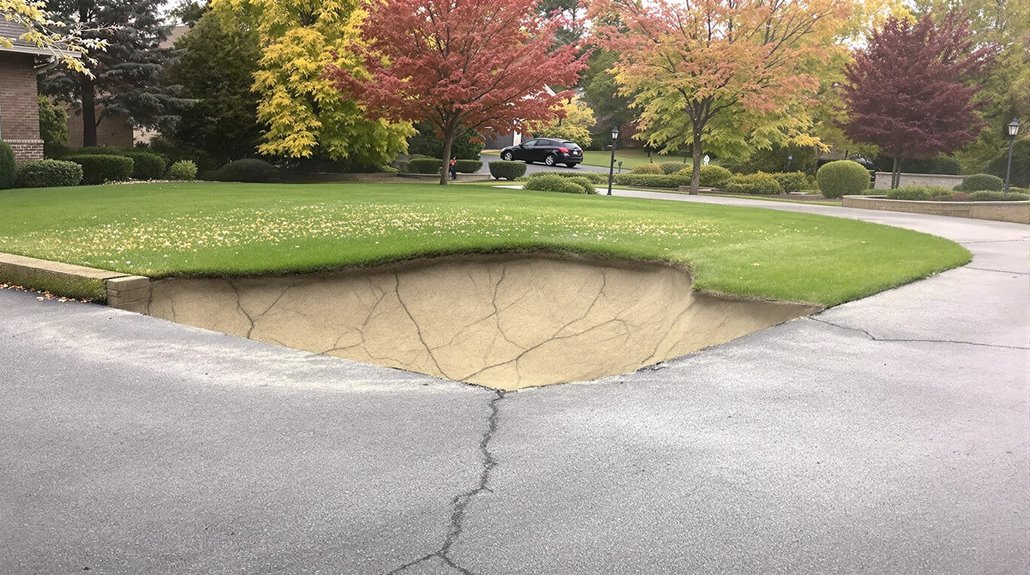
The evaluation of local geological risk factors begins with an analysis of bedrock composition, particularly focusing on soluble rock types like limestone, gypsum, and salt deposits that are prone to dissolution.
Historical mining records provide essential data about underground voids, excavations, and groundwater alterations that may compromise substrate stability.
Assessment of ground stability patterns in adjacent areas, including documented sinkholes and subsidence events, helps establish the probability of future geological hazards within the immediate vicinity.
Local Bedrock Composition Analysis
Beneath every community lies a complex foundation of bedrock that determines its vulnerability to sinkhole formation. Understanding local bedrock composition requires analysis of geological surveys and identification of susceptible rock types. Primary concerns include limestone, salt deposits, and gypsum formations, which readily dissolve when exposed to acidic groundwater.
Geophysical methods provide critical data for bedrock analysis. Seismic refraction measures depth to bedrock layers, while electrical resistivity identifies subsurface lithology. Electromagnetic surveys detect potential voids, and microgravity studies reveal density anomalies indicative of underground cavities.
These assessment tools are particularly essential in karst terrain, where soluble bedrock creates heightened risk. Areas with unconsolidated sediments overlying soluble bedrock warrant careful monitoring through multiple analytical methods to detect early signs of subsurface instability.
Historical Mining Activity Records
Mining activity records provide vital historical data for identifying potential sinkhole hazards, particularly in regions with extensive underground excavation history.
The Nevada Bureau of Mines and Geology (NBMG) maintains thorough databases documenting historical mining operations, including surface and underground mine maps, production figures, and environmental evaluations dating back to the 1860s.
These historical mining records serve as vital indicators for evaluating geological risks, as abandoned mine workings can create subterranean voids susceptible to collapse.
Organizations like NBMG, USGS, and the U.S. Bureau of Mines offer electronically indexed files that enable researchers and developers to review specific locations for potential hazards.
When combined with geophysical surveys and microgravity measurements, mining records help identify areas where underground cavities may pose sinkhole risks, particularly in regions with karst terrain or significant groundwater fluctuations.
Nearby Ground Stability Patterns
Ground stability patterns in a given area emerge from complex interactions between geological, hydrological, and topographical factors that collectively determine sinkhole susceptibility.
Geological maps provide critical insights into local rock types, soil compositions, and structural features that influence ground stability. Areas with dissolvable rocks, particularly limestone and carbonate formations, demonstrate higher vulnerability to sinkhole formation.
Key indicators of ground instability include the presence of highly jointed or faulted rock structures, which create pathways for water infiltration.
Regions with clay or silt-rich soils exhibit increased risk due to their water retention properties, while areas with elevated groundwater levels face heightened susceptibility.
The analysis of terrain characteristics, such as steep slopes and high topographic relief, further aids in identifying zones prone to ground instability and potential sinkhole development.
Common Indoor Warning Signs
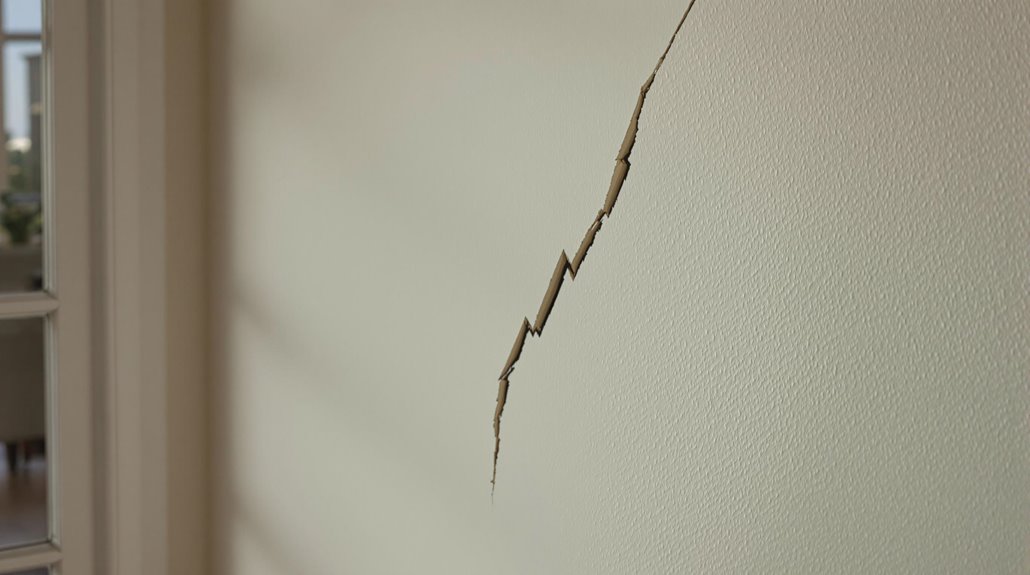
Homeowners can identify potential sinkhole development through several distinct indoor warning signs that manifest within the structural components of their residence.
These warning signs frequently present as structural deformations, including cracks in walls, floors, and foundations, particularly around door and window frames. The progressive deterioration often manifests in operational difficulties, such as problems closing doors or windows due to shifting foundational elements.
Critical indoor signs include the separation of walls from floors or ceilings, indicating substantial structural displacement. Observable floor sloping and uneven surfaces throughout the residence suggest underlying ground instability.
Foundation settling may become evident through progressive cracking patterns and visible structural misalignment. The presence of these indicators, especially when occurring simultaneously, warrants immediate professional assessment, as they potentially signify subsurface void formation characteristic of sinkhole development.
These structural manifestations typically correlate with subterranean geological changes affecting the building’s foundation integrity.
When and How to Get Professional Help

While indoor warning signs provide initial indicators of potential sinkhole formation, professional evaluation becomes necessary when specific conditions manifest. Effective sinkhole prevention requires immediate emergency response when structural damage, deep sinkholes, or sudden ground changes occur. Professional intervention becomes critical when water rapidly disappears into the ground or when well water levels unexpectedly drop.
| Professional Type | Primary Function |
|---|---|
| Certified Home Inspector | Structural assessment and foundation evaluation |
| Geotechnical Engineer | Analysis of soil conditions and repair recommendations |
| Licensed Geologist | Investigation of geological factors and root causes |
| Sinkhole Specialist | Implementation of remediation techniques |
| Insurance Adjuster | Documentation and coverage assessment |
Prior to professional arrival, property owners should document damage through photographs, implement safety measures, mark sinkhole boundaries, and notify insurance providers. The complexity of sinkhole formation necessitates specialized knowledge and equipment for accurate assessment and proper remediation strategies. Additionally, property owners may want to seek advice from local authorities to understand any legal obligations or resources available for sinkhole management. Engaging with sinkhole repair experts near you can provide valuable insights into the extent of the damage and the appropriate remediation techniques. Taking these proactive steps can help ensure that the property is stabilized and any potential hazards are effectively mitigated.
The Benefits Of Consulting A Public Adjuster
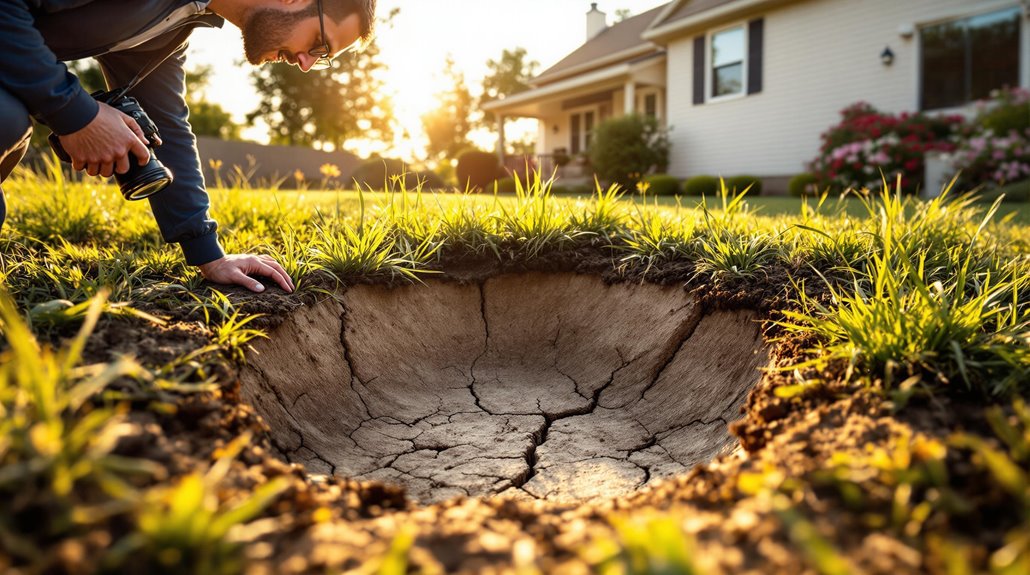
Public adjusters provide specialized expertise in evaluating sinkhole-related insurance claims through objective damage assessment protocols and extensive policy analysis.
Their professional involvement streamlines the complex documentation and negotiation processes inherent to geological hazard claims.
Statistical evidence indicates that claims handled by licensed public adjusters typically result in more substantial settlements due to their thorough understanding of coverage parameters and structural damage valuation methods.
Early engagement with licensed public adjusters ensures thorough documentation of property damage and strengthens the potential for maximum claim recovery.
Expertise In Insurance Claims
Insurance claims involving sinkholes demand specialized expertise due to their complex geological and structural implications. Public adjusters possess extensive knowledge of insurance policy coverage evaluation and claim strategies, enabling them to maximize settlement outcomes for property owners affected by sinkhole damage.
Key aspects of their expertise include:
- Analysis of policy language to identify applicable coverage and exclusions specific to ground movement events
- Documentation of geological assessments, structural engineering reports, and repair methodologies
- Strategic negotiation with insurers based on technical evidence and policy provisions
Their proficiency in interpreting complex insurance policies, combined with systematic documentation procedures, guarantees thorough claim presentation.
Public adjusters leverage their understanding of insurance company tactics while advocating for policyholders, resulting in ideal settlement outcomes through evidence-based negotiations and all-encompassing damage assessment protocols.
Operating on a contingency fee basis, public adjusters typically charge 5-20% of the final settlement amount, making their services accessible to property owners facing sinkhole damages.
Objective Damage Assessment
A thorough damage assessment conducted by licensed public adjusters provides property owners with an objective evaluation of sinkhole-related structural deterioration and associated losses.
These professionals employ systematic assessment techniques, including extensive photographic documentation, video evidence, and detailed written reports to catalog both visible and concealed structural damage.
The damage documentation process encompasses multiple inspection phases, analyzing foundation displacement, wall separation, soil subsidence patterns, and compromised support systems.
This methodical approach establishes a factual basis for insurance claim negotiations, ensuring all manifestations of sinkhole activity are properly identified and quantified.
The resulting assessment report serves as a critical tool for determining fair compensation, while maintaining transparency throughout the claims process and providing verifiable evidence of property damage extent.
Streamlined Claim Process
Leveraging professional public adjusters greatly streamlines the sinkhole damage claims process through integrated digital solutions and specialized expertise. Public adjusters facilitate efficient claims tracking while managing digital submission of documentation, ensuring maximum potential settlements for property owners affected by sinkhole damage.
Key advantages of utilizing public adjusters for sinkhole claims include:
- Implementation of automated validation systems that minimize errors and expedite processing
- Professional negotiation tactics that optimize claim outcomes through thorough policy analysis
- Integration of digital documentation platforms that enable real-time monitoring of claim status
These insurance professionals operate independently from insurance carriers, providing dedicated representation throughout the claims lifecycle.
Their expertise in maneuvering complex sinkhole damage assessments, combined with technological solutions, greatly reduces processing time while maintaining accuracy in documentation and verification procedures.
Public adjusters typically charge up to 10% commission on the final settlement amount, aligning their interests with achieving maximum compensation for property owners.
Higher Claim Payouts & Settlements
While processing sinkhole damage claims independently may seem feasible, statistical evidence demonstrates that engaging public adjusters leads to substantially higher settlement amounts.
Studies indicate that professionally represented claims typically result in settlements approximately 19% higher than those pursued without assistance ($22,266 versus $18,659).
Public adjusters achieve these higher settlements through specialized expertise in damage identification, policy interpretation, and claims advocacy.
Their extensive understanding of insurance policies enables thorough documentation of all compensable damages, preventing oversight of legitimate claim components.
Operating on a contingency basis, these licensed professionals maintain strong motivation to maximize payouts while eliminating upfront costs for policyholders.
Their expertise proves particularly valuable in complex sinkhole claims, where intricate investigation processes and technical evaluations require specialized knowledge to secure ideal compensation.
With an average salary of $61,465 annually, professional adjusters bring significant experience and knowledge to complex property damage cases.
About The Public Claims Adjusters Network (PCAN)
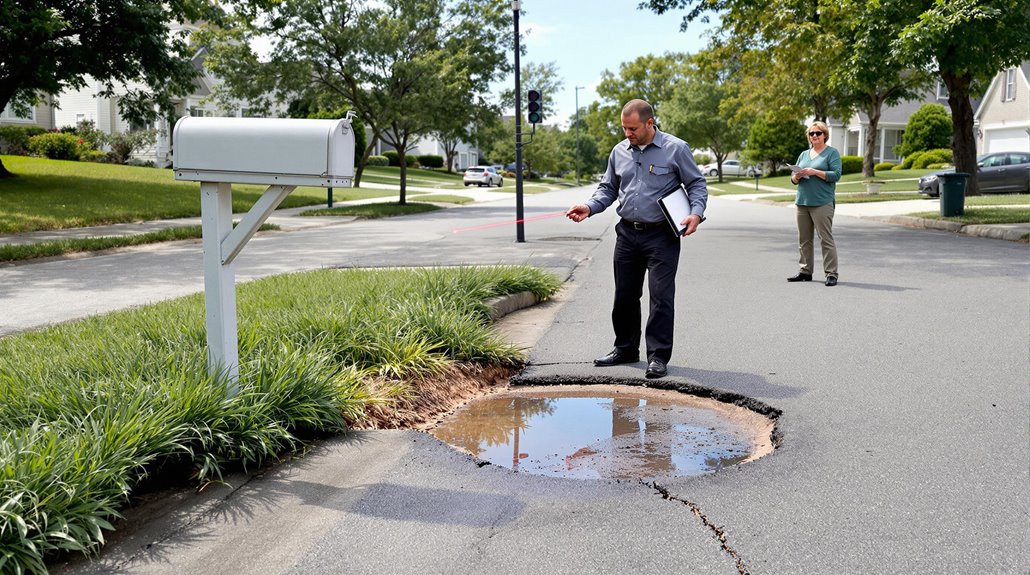
Public Claims Adjusters Network (PCAN) represents a consortium of independent insurance professionals who specialize in advocating for policyholders during insurance claims processes.
These licensed experts navigate complex policy interpretations while managing thorough damage assessments and settlement negotiations.
PCAN members execute critical Public Adjuster Roles throughout the Claims Process:
- Policy analysis and validation of insurer-presented claims
- Documentation of damages and calculation of business interruption costs
- Implementation of strategic settlement negotiations using advanced claims management software
The network adheres to state-regulated fee structures, typically ranging from 10-20% of claim settlements, with specific limitations during declared emergencies.
PCAN members leverage their expertise in construction, repair assessment, and commercial loss calculations to guarantee ideal financial recovery for policyholders.
Their collaborative approach encompasses all aspects of claims management, from initial filing through final settlement, while maintaining transparent communication with stakeholders throughout the process.
All member adjusters must demonstrate 4+ star reviews and a minimum of three years in business to qualify for PCAN membership.
Frequently Asked Questions
How Quickly Can a Sinkhole Form and Collapse Without Warning?
Like a trapdoor suddenly giving way, sinkholes can undergo rapid formation and sudden collapse within minutes to hours, particularly when triggered by groundwater changes or extreme weather events.
Can Sinkholes Be Successfully Filled and Stabilized Permanently?
Modern sinkhole remediation techniques, including engineered backfilling, grouting, and underpinning, can achieve permanent stabilization when properly implemented with thorough geotechnical analysis and appropriate long-term stabilization methods.
Does Homeowners Insurance Typically Cover Sinkhole Damage and Repairs?
Standard homeowners insurance policies typically exclude sinkhole damage. Specific sinkhole insurance must be purchased separately as a policy endorsement, with coverage limits determined by geological risk assessment and property value.
What Is the Average Cost to Repair a Residential Sinkhole?
Like a financial sinkhole itself, residential sinkhole repair costs plunge between $3,500-$25,000, with the final expenditure determined by repair methodology, structural damage extent, and geological conditions requiring remediation.
Can Seismic Activity or Earthquakes Trigger Sinkhole Formation in Vulnerable Areas?
Seismic triggers and earthquake impacts can directly initiate sinkhole formation in areas with soluble bedrock through stress changes, decompression of confined aquifers, and increased fracturing along fault damage zones.
References
- https://www.agiusa.com/blog/7-most-common-signs-sinkholes
- https://www.keele.ac.uk/how-to-detect-sinkhole/before-it-swallows-you-up.php
- https://myfoundationrepairs.com/sinkhole-warning-signs-what-to-look-for/
- https://www.getserious.com/insurance-claims/sinkholes/warning-signs/
- https://concretesolutionsofatl.com/7-signs-your-house-may-have-a-sinkhole-problem/
- https://www.un-spider.org/sinkholes
- https://www.tensarinternational.com/resources/articles/what-are-sinkholes
- https://en.wikipedia.org/wiki/Doline
- https://www.bgs.ac.uk/discovering-geology/earth-hazards/sinkholes/
- https://www.nachi.org/sinkholes.htm
